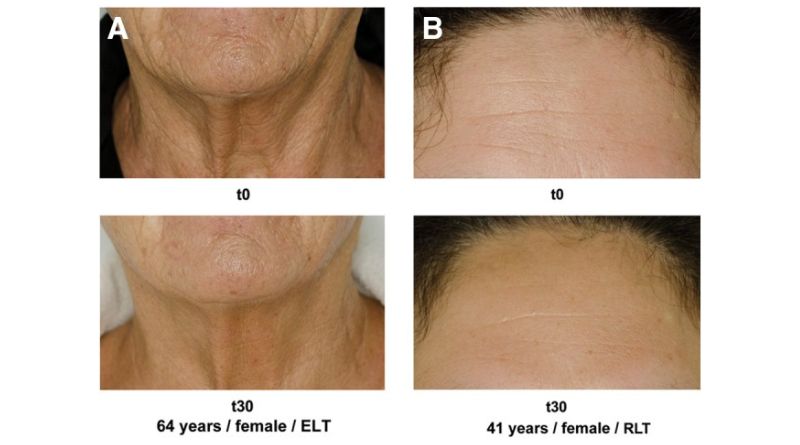Red light therapy, also known as photobiomodulation therapy, is a painless, non-invasive treatment that harnesses the power of red and near-infrared light to provide a variety of health advantages. [1] In recent years, this therapy has gained popularity, with research studies emphasising its ability to treat a wide variety of problems, from pain and inflammation to hair growth and skin rejuvenation. [9] Red light therapy has evolved in recent years as a viable and non-invasive therapeutic approach with a wide range of health advantages.
This therapeutic treatment includes exposing our bodies to low amounts of red or near-infrared light, which can penetrate the skin and have a variety of beneficial benefits. Let’s look at the amazing benefits of red light therapy and why it’s becoming popular in the health and wellness world. [8]
Red light treatment is also known by the following names:
- Low-level laser light therapy.
- Low-power laser therapy.
- Non-thermal LED light.
- Soft laser therapy.
- Cold laser therapy.
- Biostimulation, photonic stimulation.
- Photobiomodulation and phototherapy.
Is red light treatment beneficial?
Most experts believe they don’t know if RLT is effective for all of its stated applications. Most experts agree that the trials released thus far show some promise for some illnesses, but that additional research is needed. [6] Red light therapy is still a new treatment that is gaining popularity.
Clinical photography indicated noticeable wrinkle and skin roughness changes. Figure 01 depicts a comparison of baseline (t0) and t30 status for one patient in each treatment group.

Figure 01: Illustrations of patient photography. Energising light technology (ELT) is used by a 64-year-old woman. (B) 41-year-old female, red light therapy (RLT). [10]
A randomised, placebo-controlled study is the gold standard for determining if a product is beneficial. This implies that a certain number of participants with similar characteristics (age, weight, race, gender, etc.) get either the study therapy or a placebo (false or “sham” treatment) for the same ailment. Some studies also compare one therapy to another that is regularly utilised. The developing treatment’s results can then be compared against no treatment (the placebo group) or to a “current standard” treatment. [3]
Many reported RLT trials comprised just a small number of participants, did not include a placebo group, were not done in humans (animal studies), or were confined to cell tissue alone. Most academics believe that the results thus far are encouraging.
Red light treatment has the following advantages:
Red Light Therapy for Weight Loss
- Boosting Metabolism: Red light treatment has showed promise in improving metabolic function, resulting in more effective calorie burning and perhaps boosting weight reduction attempts.
- Fat Reduction: According to research, red light treatment may help remove stubborn fat deposits by activating the mitochondria in cells, hence boosting lipolysis.
Red Light Therapy for Sleep
- Regulating Circadian Rhythms: Red light exposure, particularly in the evening, can assist regulate circadian rhythms, supporting a regular sleep-wake cycle and enhancing overall sleep quality. [5]
- Melatonin Production: Red light treatment may boost the synthesis of melatonin, a hormone important for sleep, allowing people to sleep better at night.
Red Light Therapy for Pain Relief
- Alleviating Joint Pain: Red light therapy has been shown to be effective in lowering joint pain and inflammation, making it a viable adjunct treatment for illnesses such as arthritis.
- Accelerating Healing: Red light treatment can speed up the healing process and provide pain relief by increasing cellular repair and regeneration.
Red Light Therapy Devices: Convenient and Effective
- At-Home Solutions: Individuals may easily include red light therapy into their everyday routines now that home-use red light therapy equipment are available.
- Non-Invasive Treatment: Red light treatment, unlike certain medical therapies, is non-invasive, making it a safe and accessible choice for individuals seeking alternative healing approaches. [9]
Discover the transformational potential of red light treatment with Bestqool. Their cutting-edge technologies harness red light’s therapeutic advantages, encouraging skin regeneration, muscular recovery, and general well-being. Bestqool, where innovation meets wellness, may help you improve your health and energy.
Today, bring light into your life!

References:
- Sadick N.S. (2008). A study to determine the efficacy of a novel handheld light-emitting diode device in the treatment of photoaged skin. Cosmet. Dermatol.7, 263–267
- Lee S.Y., Park K.H., Choi J.W., et al. (2007). A prospective, randomized, placebo-controlled, double-blinded, and split-face clinical study on LED phototherapy for skin rejuvenation: Clinical, profilometric, histologic, ultrastructural, and biochemical evaluations and comparison of three different treatment settings. Photochem. Photobiol. B.88, 51–67
- Santana–Blank L., Rodríguez–Santana E., and Santana–Rodríguez K.E. (2012). Photobiomodulation of aqueous interfaces as selective rechargeable bio-batteries in complex diseases: personal view. Laser Surg.30, 242–249
- Calderhead R.G., Kubota J., Trelles M.A., and Ohshiro T. (2008). One mechanism behind LED phototherapy for wound healing and skin rejuvenation: Key role of the mast cell. Laser Therapy17, 141–148
- Zhang Y., Song S., Fong C.C., et al. (2003). cDNA microarray analysis of gene expression profiles in human fibroblast cells irradiated with red light. Invest. Dermatol.120, 849–857
- Jang Y.H., Koo G.B., Kim J.Y., Kim Y.S., and Kim Y.C. (2013). Prolonged activation of ERK contributes to the photorejuvenation effect in photodynamic therapy in human dermal fibroblasts. Invest. Dermatol.133, 2265–2275
- Zastrow L., Groth N., Klein F., et al. (2009). The missing link–light-induced (280–1,600 nm) free radical formation in human skin. Skin Pharmacol. Physiol.22, 31–44
- Crisan D., Crisan M., Moldovan M., Lupsor M., and Badea R. (2012). Ultrasonographic assessment of the cutaneous changes induced by topical flavonoid therapy. Cosmet. Investig. Dermatol.5, 7–13
- Webb C., Dyson M., and Lewis W.H. (1998). Stimulatory effect of 660 nm low level laser energy on hypertrophic scar-derived fibroblasts: possible mechanisms for increase in cell counts. Lasers Surg. Med.22, 294–301
- A Controlled Trial to Determine the Efficacy of Red and Near-Infrared Light Treatment in Patient Satisfaction, Reduction of Fine Lines, Wrinkles, Skin Roughness, and Intradermal Collagen Density Increase





